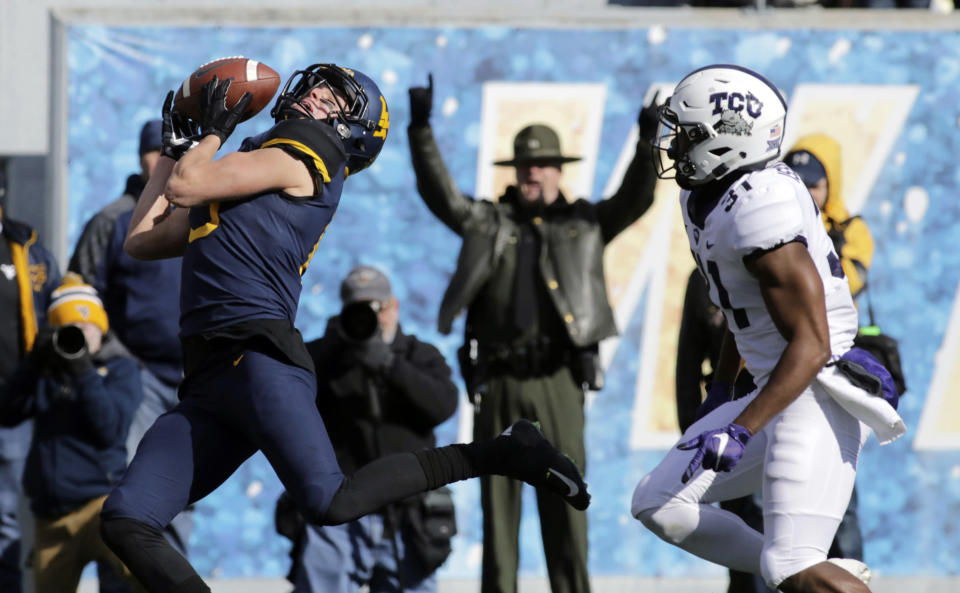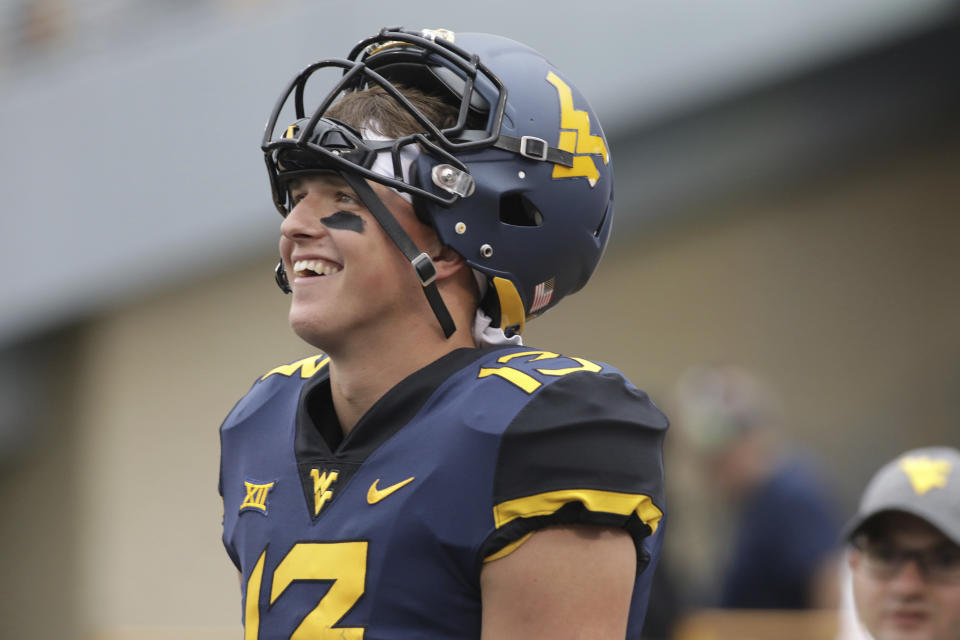From phenom to QB bust, WVU's David Sills looks to catch on in NFL as a WR

INDIANAPOLIS — When West Virginia’s David Sills V speaks to NFL scouts and coaches these days, the first thing they ask him isn’t about his unusual, circuitous path to college stardom or even his outstanding, dynamic production as a receiver.
No. Much to Sills’ amusement, it appears NFL types believe speed still kills.
“Usually the first thing that comes up is, ‘What are you gonna run?” Sills told Yahoo Sports with a chuckle in a phone interview on Monday. “If a receiver is a 4.3 [seconds] or 4.4 guy, then that’s the first question that comes up — can they stretch the field vertically?”
And while the 6-foot-4 Sills — who expects to check in a little north of 210 pounds at this week’s NFL scouting combine — knows he’s no conventional speed merchant, he cannot wait to show off his wheels when receivers run the 40-yard-dash Saturday.
“I think I’ve done enough to prove I can be a vertical threat based on my film,” Sills said. “But … I’m very confident that I’m gonna run a great time, and run something that a lot of people are gonna kinda be shocked about.”
Sills does not lack confidence, and if a player is going to make it in the NFL as a second-to-third-day pick — where Sills is largely projected to go in this year’s draft — that type of belief is often healthy and necessary.
After all, Sills needed every bit of it to make it this far. Although he found fame early in his life, when then-USC coach Lane Kiffin made national news by offering a 13-year-old Sills a scholarship as a quarterback in 2010, it would have been easy for him to tuck tail, wilt under the pressure and quit on his football career many times since then. He could have done it playing high school ball in Maryland, for instance, when opponents — who were excited about facing Sills, a virtual celebrity thanks to Kiffin’s uber-early scholarship offer — trash-talked and attacked him on the field with vigor.
And he also could have done it after he arrived at West Virginia in 2015 — he’d decommitted from USC after Kiffin was fired two years prior — and not only failed to win the starting quarterback job his first two years on campus, but quickly fell behind on the depth chart and looked like a long shot to earn meaningful snaps in coach Dana Holgorsen’s Air Raid offense.
“I got a lot of the Todd Marinovich comparisons,” Sills said, referring to the troubled USC and Raiders star quarterback. “A lot of people didn’t think I would really amount to much.”

Sills even could have done it in 2016, when he transferred to El Camino College in California so he could play quarterback — on his own dime, since California community colleges don’t provide athletic scholarships.
“I just had to go out on a limb and not be afraid to fail [at El Camino],” Sills said.
In 2016, Sills was solid (throwing for 1,636 yards and 15 touchdowns) but unspectacular. And that’s all he needed to see that his NFL future wouldn’t be at the position he loved, despite all the early hype (thanks to Kiffin’s offer), as D-1 colleges didn’t show interest in him as a quarterback during or after that season.
But Sills loved football, and the thing that meant the most to him was making the NFL — by any means necessary. He’d shown flashes at receiver early on at West Virginia, when he played the position just to get on the field, and his coaches never wanted him to transfer in the first place.
So with the dream of playing quarterback in the NFL finally out of his system, Sills was certainly receptive when those same coaches — who were keeping tabs on him at El Camino — dialed him up and offered him a scholarship to return and play receiver for the 2017 season.
Turns out Sills’ quarterbacking background would turn into a massive plus in his second go-round at West Virginia. He’d learned how to study defenses as a signal-caller, which paid off immediately since he knew how to attack the film room and find the natural voids in defensive coverages. And since he was familiar with all the responsibilities that come with playing quarterback, he built a quick, close bond with quarterback Will Grier.
Together, the two grew into one of the best quarterback-receiver batteries in college football, as Grier — who is also a projected second- or third-day pick in this year’s draft — helped Sills average nearly 63 catches, 983 yards and 17 touchdowns in 2017 and 2018.
During the course of those two seasons, Sills showed NFL traits. He was courageous over the middle and he was terrific at both high-pointing contested balls and tracking deep balls over his shoulder. What’s more, Sills became a red-zone weapon as his size and natural ball skills allowed him to be nearly unstoppable on slants and fades near the end zone.
“When he throws the ball and you know it’s going to land in the paint — that’s what we call the end zone — it almost brings a different gear out of you, whether it’s speed or focus or whatever it is,” Sills said.
Sills’ positive traits will get him drafted in today’s pass-happy NFL, but he’s a worker, and he knows he also has to eliminate the drops that occasionally bedeviled him and improve against press coverage, which is often challenging for rookie receivers in the NFL.
“I’m going to get a lot more reps on the bench press than people think I’m gonna get,” Sills said.
He says this in a similar tone to the one he used earlier, when Sills made it clear he’s aiming to “shock” scouts with his 40-yard dash time.
And given the resilience Sills has shown in his career, when he went from a 13-year-old quarterbacking phenom to a 20-year-old quarterback bust and somehow came out clean on the other side as a jump-ball snaring, big-bodied NFL receiving prospect, perhaps people should start giving him the benefit of the doubt.
Sills, for his part, doesn’t worry about that. All he knows is that while he expects NFL talent evaluators to ask more questions about his speed this week — at least until he runs the 40 — those same evaluators would also be wise to ask him how he has gotten to this point if they want to know what he’s really about.
“It’s been a wild ride and a wild journey, and I love telling the story,” Sills said. “I don’t have any regrets with what happened when I was younger. I think it just shows what kind of person I am.”
More from Yahoo Sports:

